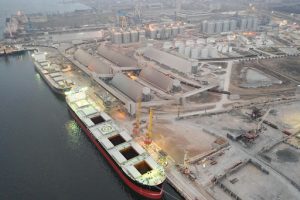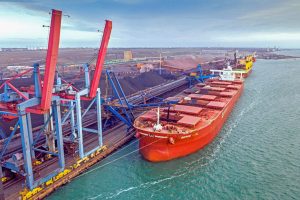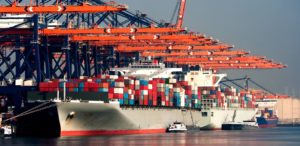
Nika-Tera Sea Terminal (Sea Specialized Port Nika-Tera, Mykolaiv), part of Dmytro Firtash’ Group DF, handled 409 vessels and 7.38 million tonnes of cargo in 2020, which is 15% lower than in 2019.
According to the company’s website, the main types of cargo handled in the port are grain, legumes and oilseeds, as well as their processed products.
In 2020, the port started handling oil products and resumed handling fertilizers.
“The coronavirus [COVID-19] pandemic and the drop in crop yields are the main reasons for the 14% decrease in cargo handling. In 2020, grain was the main type of cargo handled in the port. At the same time, the crisis helped us open a new ‘window of opportunity’: we are talking about the restoration of volumes of mineral cargo and bitumen handlings,” CEO of Nika-Tera Alim Agakishiev commented on the results of the past year.
The structure of the company’s cargo turnover in 2020 looked as follows: grain, legumes and oilseeds, as well as their processed products accounted for 75% (some 5.55 million tonnes) of handling; open storage bulk cargo for 18% (some 1.3 million tonnes); liquid cargo for 4% (some 323,000 tonnes) and mineral fertilizers for 3% (some 194,000 tonnes).
In 2020, the port handled 409 vessels (versus 410 in 2019), while increasing the number of processed bulk carriers of the Panamax type (with a tonnage of about 65,000 tonnes) by 44% from 16 to 23 units.
In total, 63,114 rail cars and 65,910 vehicles were handled in the port.
Despite the COVID-19 pandemic, the port was able to ensure 100% retention of the company’s personnel and large-scale assistance to the city’s healthcare sector in the fight against COVID-19.
“We believe in a gradual recovery of the market, economy and, accordingly, the volume of cargo turnover in 2021. However, much will depend on weather conditions and the yield of key crops in this marketing year,” Agakishiev said.

The seaports of Ukraine in January-September 2020 handled, according to recent data, 118.78 million tonnes of cargo, which is 3.7% more compared to the same period in 2019.
According to the latest information on the website of the Ukrainian Sea Ports Authority, transshipment of exported cargo increased to 91.1 million tonnes (5.6% more), cabotage cargo to 1.8 million tonnes (31% more), and transshipment of imported goods decreased to 18 million tonnes (3.1% less), transit to 7.7 million tonnes (5.5% less).
The leaders in terms of transshipment volumes are ore and grain. During this period, the first place was occupied by grain cargo, the transshipment of which amounted to 35.3 million tonnes.
Ore ranked second with the amount of 33.8 million tonnes, which is 25.5% more than the same indicator of the previous year.
Transshipment of ferrous metals increased by 8.9%, to 12.86 million tonnes, oil by 5.6% in the volume of 4.49 million tonnes, and oil by 2.8 times, with a processing volume of 1.6 million tonnes.
Transshipment of containers reached 772,900 TEU and exceeded the last year’s figure by 8.3%.

In January-April 2020, the seaports of Ukraine handled more than 55 million tonnes of cargo, which is 12.6% more compared to the same period in 2019.
According to the statement of the Ukrainian Sea Ports Authority on the state-owned enterprise’s website, traditionally, the leaders in transshipment are grain and ore.
Over the indicated period 18.7 million tonnes (5% more) of grain and 13.8 million tonnes of ore (30.5% more) were handled.
Handling of coal doubled to 2.5 million tonnes and that of crude oil increased by five times to 800,000 tonnes. Transshipment of containers by Ukrainian ports amounted to 357,700 TEU (up by 17.2%).
According to the Sea Ports Authority, handling of exported cargo increased due to a rise in transshipment of grain to 18.2 million tonnes (by 5.3%), iron ore to 10.9 million tonnes (by 45.4%), oil to 2.2 million tonnes (by 8.8%).
Transshipment of imported cargoes increased due to a rise in handling coal to 2.3 million tonnes (by 106.9%) and crude oil to 500,000 tonnes (by 213.6%), and oil products to 400,000 tonnes (by 233.3%).
Transit transportations increase due to a rise in handling ore to 1.1 million tonnes (by 34%) and crude oil to 400,000 tonnes.
Four seaports led in terms of cargo handling: Pivdenny, Mykolaiv, Chornomorsk and Odesa. In general, they processed 47.7 million tonnes of cargoes, which is 87% of the total volume of cargo handling by Ukrainian seaports.

The private port operator Ascet Shipping increased the grain handling in Berdiansk seaport to 1.134 million tonnes in 2019, which is 62% more than in 2018 (700,349 tonnes).
According to the company’s press service reported on Tuesday, March 17, the volume of handling by Ascet Shipping in Berdiansk seaport has already exceeded 3 million tonnes since it has been working as a port operator (2016).
According to the company’s report, the port operator handled 1.134 million tonnes of cargo, servicing 161 vessels in 2019.
“In the status of a port operator in Berdiansk seaport, Ascet Shipping invested about $4.3 million of its own funds in the development of infrastructure providing grain export through the berths of Berdiansk port. In particular, a port warehouse complex with a capacity of about 100,000 tonnes, a convoy, and modern laboratories were created. The port’s berths were equipped with new technological handling equipment, which allows loading five grain vessels at the port’s berths at the same time,” the company said.
According to the statement, Ascet Shipping has created more than 300 jobs over three and a half years of work in the status of a port operator.
Ascet Shipping is included in top 30 of the largest stevedoring companies in Ukraine and is the largest port operator of Berdiansk seaport.

Chornomorsk seaport (Odesa region) in January-November 2019 increased cargo transshipment by 21.8% compared to the same period in 2018, to 23.572 million tonnes.
According to the Ukrainian Sea Ports Authority, during this period Chornomorsk port increased transshipment of exported cargo by 22.4%, to 18.061 million tonnes, imported goods by 16.2%, to 4.4 million tonnes, transit cargo by 20.6%, to 933,710 tonnes, and also significantly increased transshipment of cabotage freight, by 4.1 times, to 200,570 tonnes.
Transshipment of liquid cargo in the port in January-November increased by 7.2%, to 1.510 million tonnes, dry bulk cargo by 23.9%, to 16.238 million tonnes, packaged goods by 20.6%, to 5.823 million tonnes.
Transshipment of containers amounted to 125,078 TEU (an increase of 11.2%).
As reported, the volume of transshipment at the port in 2018 rose by 25.02% compared to 2017, to 21.54 million tonnes.

Pivdenny seaport (Odesa region), the largest seaport in Ukraine in terms of transshipment volume, increased cargo transshipment by 28.4% in January-September 2019 compared to the same period in 2018, to 38.658 million tonnes.
According to information from the Ukrainian Sea Ports Authority, for the specified period the port increased transshipment of exported cargo by 36.4%, to 28.304 million tonnes, imported freight by 6%, to 5.292 million tonnes, transit by 19.1%, to 5.043 million tonnes.
In January-September, the seaport handled only 12% of the volume of cabotage cargo compared to the same period in 2018, which amounted to 17,450 tonnes.
According to the nomenclature of cargo, in January-September the port raised transshipment of liquid cargo by 10.3%, to 3.265 million tonnes, dry bulk cargo by 34.8%, to 32.285 million tonnes, and reduced transshipment of packaged goods by 2.9%, to 3.107 million tonnes.
Container transshipment amounted to 144,985 TEU (an increase of 87.8% compared to the same period in 2018).
As reported, in 2018 the port increased transshipment of goods by 1.92% compared to 2017, to 42.702 million tonnes.
Pivdenny port was founded in 1978. It is located on the Adzhalyk firth and is the deepest harbor in Ukraine. The length of its berths is around 2.6 kilometers.